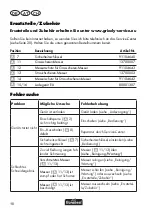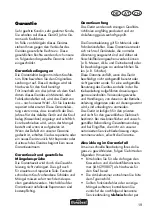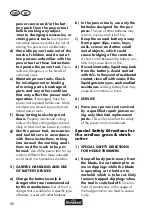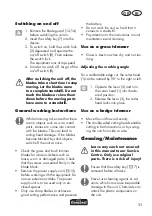
25
GB
IE
or unplugging the power tool.
Keep cord away from heat, oil,
sharp edges or moving parts.
Damaged or entangled cords increase
the risk of electric shock.
e) When operating a power tool
outdoors, use an extension cord
suitable for outdoor use.
Use of a
cord suitable for outdoor use reduces
the risk of electric shock.
f) If operating a power tool in a
damp location is unavoidable,
use a residual current device
(RCD) protected supply.
Use of an
RCD reduces the risk of electric shock.
3) PERSONAL SAFETY
a) Stay alert, watch what you are
doing and use common sense
when operating a power tool.
Do not use a power tool while
you are tired or under the influ
-
ence of drugs, alcohol or medi-
cation.
A moment of inattention white
operating power tools may result in
serious personal injury.
b) Use personal protective equip-
ment. Always wear eye protec-
tion.
Protective equipment such as dust
mask, non-skid safety shoes, hard hat,
or hearing protection used for appro-
priate conditions will reduce personal
injuries.
c) Prevent unintentional starting.
Ensure the switch is in the off-
position before connecting to
power source and/or battery
pack, picking up or carrying
the tool.
Carrying power tools with
your finger on the switch or energising
power tools that have the switch on
invites accidents.
d) Remove any adjusting key or
wrench before turning the pow-
er tool on.
A wrench or a key left at
-
tached to a rotating part of the power
tool may result in personal injury.
e) Do not overreach. Keep proper
footing and balance at all times.
This applies especially when
working on slopes.
This enables
better control of the power tool in unex
-
pected situations.
f) Dress properly. Do not wear
loose clothing or jewellery.
Keep your hair, clothing and
gloves away from moving
parts.
Loose clothes, jewellery or long
hair can be caught in moving parts.
g) If devices are provided for the
connection of dust extraction
and collection facilities, ensure
these are connected and prop-
erly used.
Use of dust collection can
reduce dust-related hazards.
h) Walk when holding the device
in your hand.
Do not run.
i) Do not touch any of the danger-
ous moving parts before you
have removed the battery and
all moving parts have come to a
complete standstill.
There is a risk
of injury.
4) POWER TOOL USE AND CARE
a) Do not force the power tool. Use
the correct power tool for your
application.
The correct power tool
will do the job better and safer at the
rate for which it was designed.
b) Do not use the power tool if the
switch does not turn it on and
off.
Any power tool that cannot be
controlled with the switch is dangerous
and must be repaired.
c) Disconnect the plug from the
















































